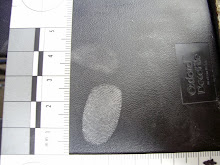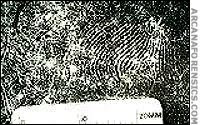 Have you ever wanted to be like Inspector Clueso or like a CSI person or wondered how the things they did worked? One of the most important "clues" in forensics is fingerprinting. There are many different ways to develop fingerprints, some may seem obvious or others may be impressive or mysterious looking. For example, have you ever been watching CSI or NCIS and they produce a gaseous fume and some how it makes the fingerprints vi sable? This may seem like magic or you may say "that's just a TV thing." Well I have news for you...its not! Have you ever heard of something called cyanoacrylate? no? How about superglue? Superglue's particles , when heated, tend to stick on the oils leftover from the ridges on your fingerprint. And when it dries, it stays. We also have access to chemicals like Vacuum Metal Deposition or VMD. This is usually used on items like a plastic bag but can be used on objects that have been submerged in water! You would that water would wash away the print but when the VMD dissolves a layer of gold followed by Zinc the print becomes visable. Although today recycled bags are more common, so for those they made a VMD that dissolves the silver once again leaving the print.
Have you ever wanted to be like Inspector Clueso or like a CSI person or wondered how the things they did worked? One of the most important "clues" in forensics is fingerprinting. There are many different ways to develop fingerprints, some may seem obvious or others may be impressive or mysterious looking. For example, have you ever been watching CSI or NCIS and they produce a gaseous fume and some how it makes the fingerprints vi sable? This may seem like magic or you may say "that's just a TV thing." Well I have news for you...its not! Have you ever heard of something called cyanoacrylate? no? How about superglue? Superglue's particles , when heated, tend to stick on the oils leftover from the ridges on your fingerprint. And when it dries, it stays. We also have access to chemicals like Vacuum Metal Deposition or VMD. This is usually used on items like a plastic bag but can be used on objects that have been submerged in water! You would that water would wash away the print but when the VMD dissolves a layer of gold followed by Zinc the print becomes visable. Although today recycled bags are more common, so for those they made a VMD that dissolves the silver once again leaving the print.People wonder: How did we discover this stuff? Well it all started in 1823 with a man named Purkinje who classified fingerprints as 9 types.

Then 20 years later in 1870 Dr. Henry Faulds realized the importance of fingerprints as a means of identification and devised a means of lifting them via ink. Then in 1892 a policeman named Juan Vucetich booked Francis Rojas, a woman who murdered her 2 sons, and her file included Rojas' fingerprints. Then everything shot up exponentially and today in 2009, America holds about 100,000,000 fingerprints of criminals in the largest AFIS building in the US.
Today there are many ways of developing and collecting fingerprints. Another modern technique for developing fingerprints is using a chemical called Silver Nitrate. This can be found in black and white photographic film. When the chlorine in the oils of your hand mix with the silver nitrate and it creates silver chloride. This makes it visible in a UV light and makes a reddish brown color. This can be followed by collecting the fingerprint by taking a picture of it. Another rather "old fashioned" method is to use ninhydrin. This surprisingly takes a very long time to react with the oils in your hand and can take hours. If you heat it, it wont take as long and the print only lasts a few minutes. So if you spray on a mixture of water and starch it will stay for weeks maybe months. You can collect the fingerprint if the object is small enough to take back to the lab. There is also the classic powder and brush to develop it and then lift the fingerprint with tape. The last method of collecting a fingerprint is using Iodine. When it is heated it releases fumes that react with the oils left over from the fingerprint and makes it visible with a brownish color. You can also lift fingerprints by pressing it into a soap, wax or putty.
There are 3 different types of fingerprints: Latent, plastic, and direct. Latent fingerprints are left from the oils on the ridges of your finger. It is invisible to the naked eye, therefore it has to be developed. The second is plastic like if you touch something plastic it will leave a negative impression of your fingerprint. This happens in things like a bar of chocolate, candles, newly painted objects, fresh cement or in the sticky stuff on envelops or stamps. Direct is a visible fingerprint that is made visible by things like flour, soot, dust ink ect.





